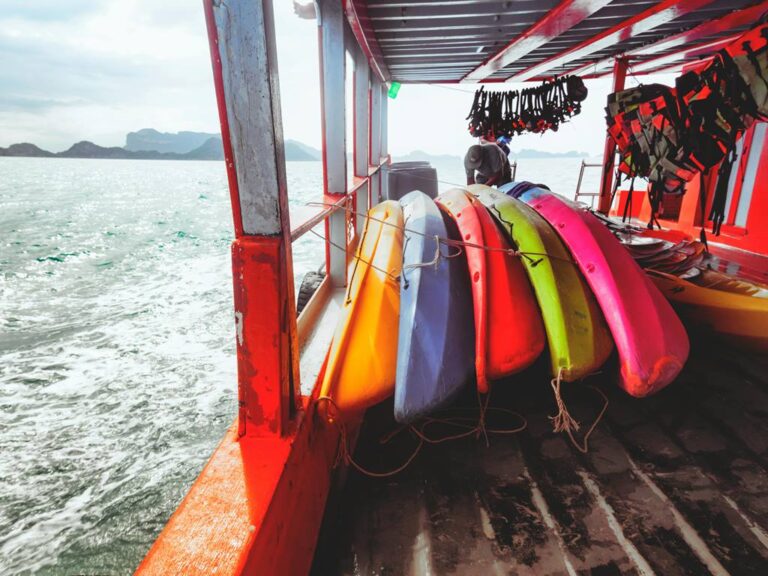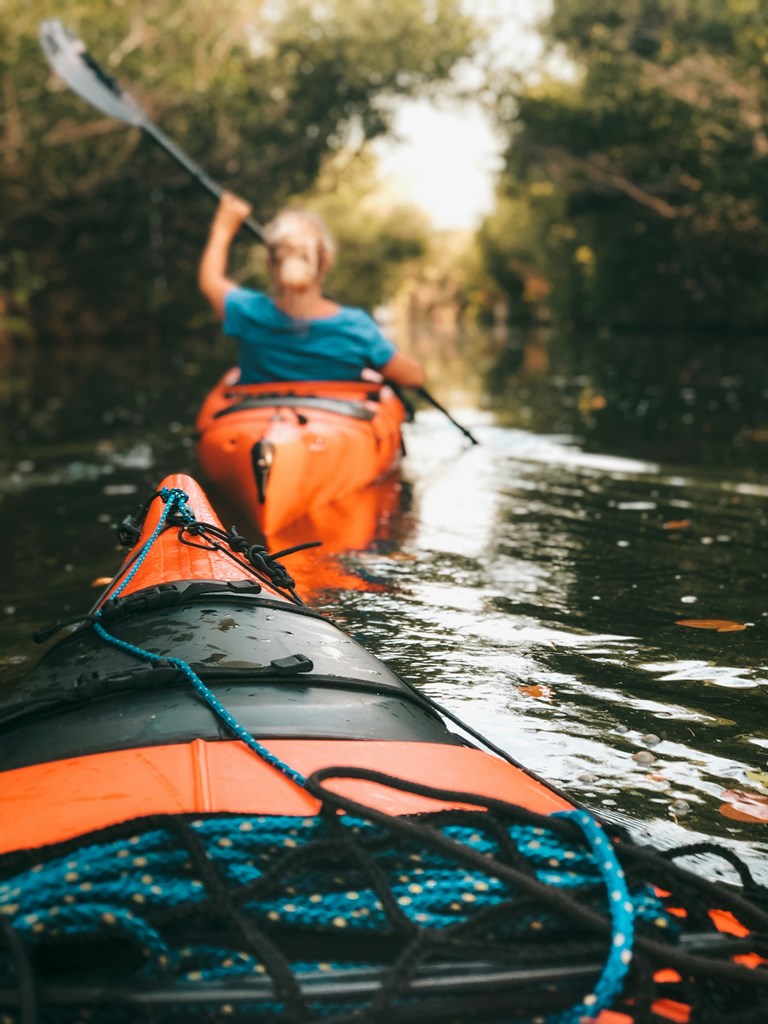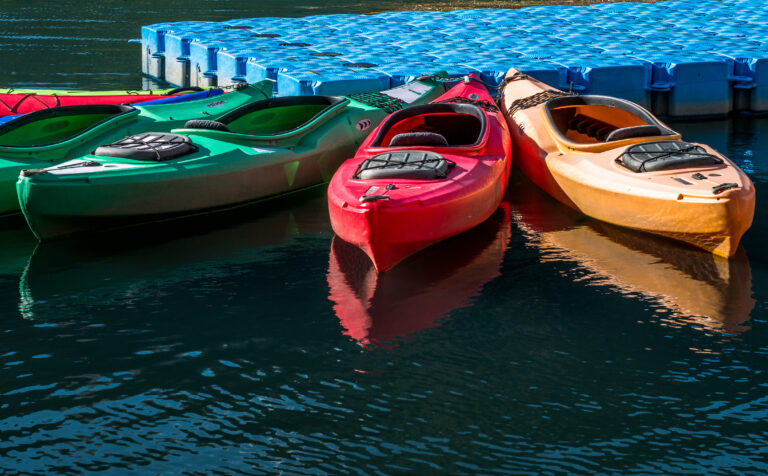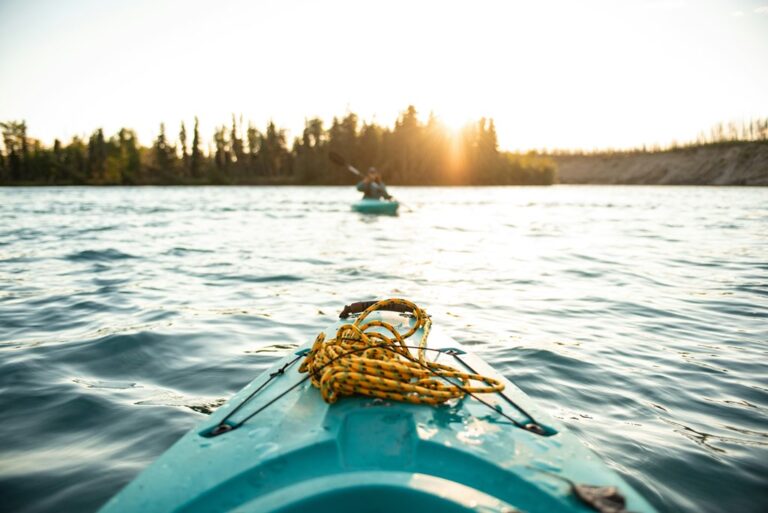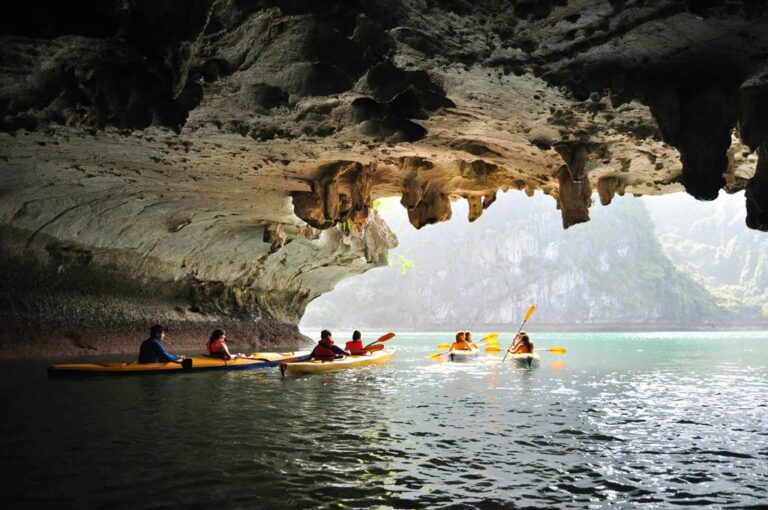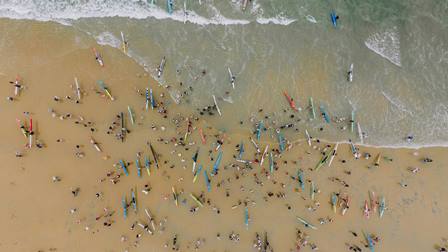
Forget limitations! Kayak camping lets you explore hidden gems unreachable by bigger boats. Planning an overnight kayak camping trip? This ultimate guide provides essential tips, key information, and a detailed packing list to ensure you’re fully prepared for an unforgettable adventure!
Table of Contents
Kayak Camping Benefits
Kayak camping offers a unique blend of adventure and tranquillity. It unlocks hidden gems, provides a healthy dose of challenge, and fosters unforgettable memories. If you’re considering this exciting activity, this comprehensive guide will equip you with the knowledge and steps to embark on your kayak camping adventure.
1. Explore Unforgettable Destinations:
One of the most captivating aspects of kayak camping is reaching remote locations inaccessible by land or larger boats. Imagine paddling into secluded coves, hidden beaches, or serene coves – all while being one with nature. You can even embrace the spirit of discovery and simply follow the current (or the river) and see where your kayak takes you!
2. Unwind and Reconnect in Nature:
Nature itself is a powerful stress reliever, and kayak camping combines this serenity with the gentle exercise of paddling. This translates to a double dose of endorphins, leaving you feeling rejuvenated and at peace.
3. A Challenge for the Seasoned Paddler:
For those who’ve mastered the art of kayaking and crave a new challenge, kayak camping presents the perfect opportunity. The additional weight of camping gear combined with the navigation complexities of finding the ideal campsite will push your kayaking skills to the next level.
4. Family Fun on the Water:
The beauty of kayaking and camping is their suitability for families. You can even include your furry friend in the adventure! Kayaking, in particular, offers a fantastic opportunity to bond with your children. Imagine being a team in a kayak, free from distractions like phones and tablets. This shared experience, coupled with a remote camping adventure, can create lasting memories and strengthen your family connection.
Tip: Tandem kayaks are ideal for family outings, providing extra space for both kids and camping gear.
Trip Planning

So, you’re hooked on the idea of kayak camping? Let’s dive into the essential steps before your overnight expedition.
Planning Your Route:
- Start Small: Especially for first-timers, avoid diving headfirst into challenging routes. Opt for a shorter distance with calmer waters to build confidence and hone your skills.
- Short and Sweet: Longer trips demand more gear, making your kayak cumbersome. Begin with a one or two-day adventure to get comfortable with managing weight on the water. Practice makes perfect – the more you paddle with additional weight, the easier it becomes to maintain balance.
- Share Your Itinerary: Safety first! Always inform a trusted friend or family member about your planned route and campsite location. In case of emergencies, they’ll have crucial details to alert search and rescue teams.
Weather Wisdom:

Weather can dramatically impact your trip. Nobody enjoys kayaking and camping in a storm!
- Double Check the Forecast: Monitor the weather leading up to your trip and confirm again the morning of your departure. Ideal conditions? Paddle on! But if a storm or severe weather is brewing, postpone your adventure for a safer weekend.
- Weather Dictates Your Gear: Sunny skies call for sunscreen and sun protection, while chilly, wet, or windy conditions necessitate rain gear, extra layers, and potentially a warmer sleeping bag. Remember, weather can be unpredictable, so pack for a variety of situations.
Evaluate Your Kayak’s Load Capacity
Every kayak has a weight limit, known as its load capacity. This determines how much weight the kayak can safely support while remaining buoyant. While paddling without gear likely keeps you well below this limit, kayak camping adds equipment, potentially pushing you closer to – or even exceeding – the maximum capacity.
Overloading your kayak has consequences. Excess weight can cause it to sink lower in the water, making paddling and manoeuvring significantly more challenging. Here’s how to avoid exceeding your kayak’s capacity and ensure a smooth (and safe) adventure:
- Know the Numbers: Find your kayak’s weight capacity, usually printed on a label or sticker. This is the total weight your kayak can handle, including yourself, passengers, and gear.
- Weigh Yourself and Your Crew: Grab a scale and weigh yourself and anyone joining you on the trip. Add these weights together.
- Gear Up Wisely: Weigh each piece of camping gear you plan to bring, including food and water. Remember, every pound counts!
- Stay Under the Limit: Combine all the weights (people and gear) and ensure the total is at least 10 pounds under your kayak’s maximum capacity. This safety buffer allows for unexpected weight gain from water absorption in your gear or choppy water conditions.
Weight Distribution: Balance Gear Weight
It’s not just about total weight – even distribution is crucial for a smooth kayak camping experience. After finalizing your gear list, consider how you’ll arrange it within the kayak.
Balancing the Front and Back:
- Avoid a Seesaw Effect: Don’t overload the back. A heavily laden stern will cause the bow to rise, making paddling inefficient and potentially leading to water splashing into the cockpit.
- Balance is Key: Distribute weight evenly throughout the kayak. Heavier items can be placed near the center, with lighter gear towards the bow and stern.
Maintaining Side-to-Side Balance:
- Keep it Level: Unequal weight distribution from left to right will cause your kayak to tilt. A dip on one side increases drag and makes paddling more difficult.
- Pack Smart: Pack heavier items on opposite sides of the kayak to create a counterbalance effect.
Practice Makes Perfect:
- Test Run on Land: Before hitting the water, simulate your on-the-water packing by placing your kayak on grass or carpet and arranging your gear. This helps visualize weight distribution and saves time at the launch.
Pre-Check: Ensure Kayak’s Proper Functionality
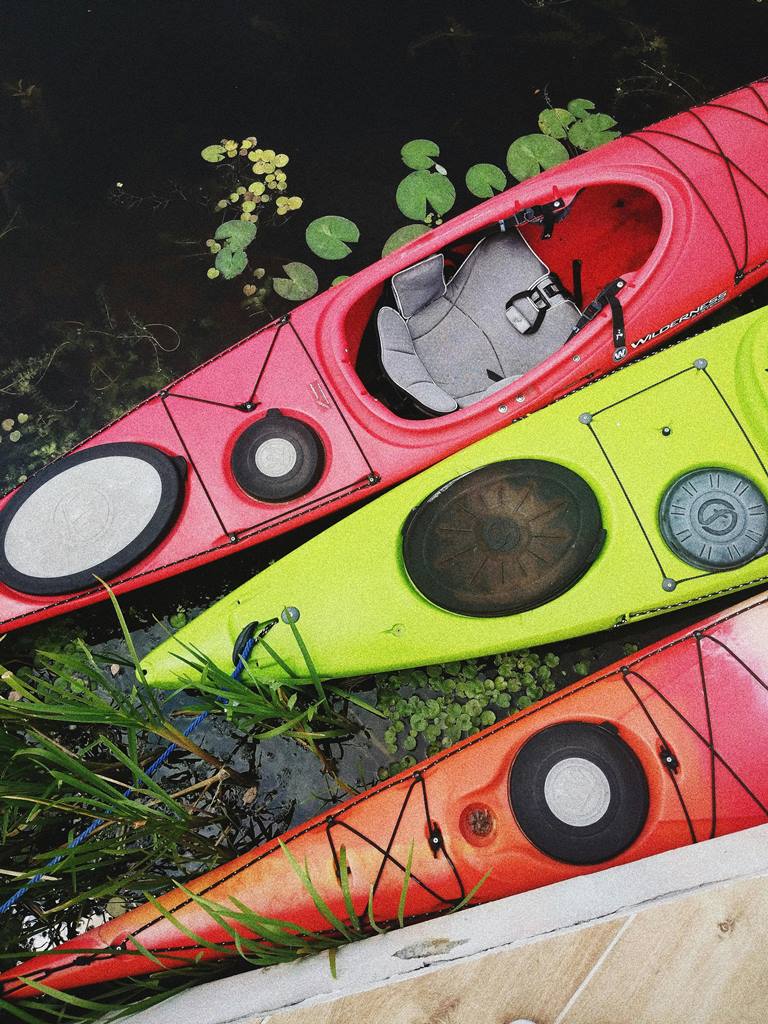
Before embarking on your kayak camping adventure, a crucial step often overlooked is inspecting your kayak for potential damage. Imagine paddling for miles, only to discover a hidden crack taking on water. A quick inspection can prevent this nightmare scenario and ensure a safe and enjoyable trip.
Here’s why a pre-departure checkup is essential:
- Early Detection, Early Repair: Small cracks or weak spots can worsen over time, especially with the added stress of paddling and gear weight. A timely inspection allows you to identify and address any issues before they become major problems.
- Safety First: A damaged kayak can compromise your safety. Water leaks can make paddling difficult and potentially lead to a capsize. Taking the time to ensure your kayak is in good condition minimizes safety risks.
Double-Check Your List Before Departure
While the full kayak camping checklist awaits, it’s vital to discuss the importance of double-checking your gear and list before departure. We’ve all experienced the sinking feeling of realizing a crucial item was left behind at home. On a remote camping trip, forgetting something essential can be a major setback.
The Power of the List:
- Create a Comprehensive List: Write down everything you’ll need or want for your trip. This includes clothing, camping gear, food, water, and kayak-specific items.
- The Tick-Off Technique: As you pack, check each item off your list to ensure it’s included. This simple step significantly reduces the risk of forgotten essentials.
Last-Minute Reminders:
- Dedicated List Section: At the bottom of your list, designate a section for “last-minute” items – things you might forget in the pre-departure rush. Sunscreen, bug spray, or your favourite camp mug are perfect examples.
- Phone Alarm to the Rescue: Set a reminder on your phone for an hour before your departure specifically for these last-minute essentials. This extra step can save you from scrambling at the last minute.
Selecting the Right Gear
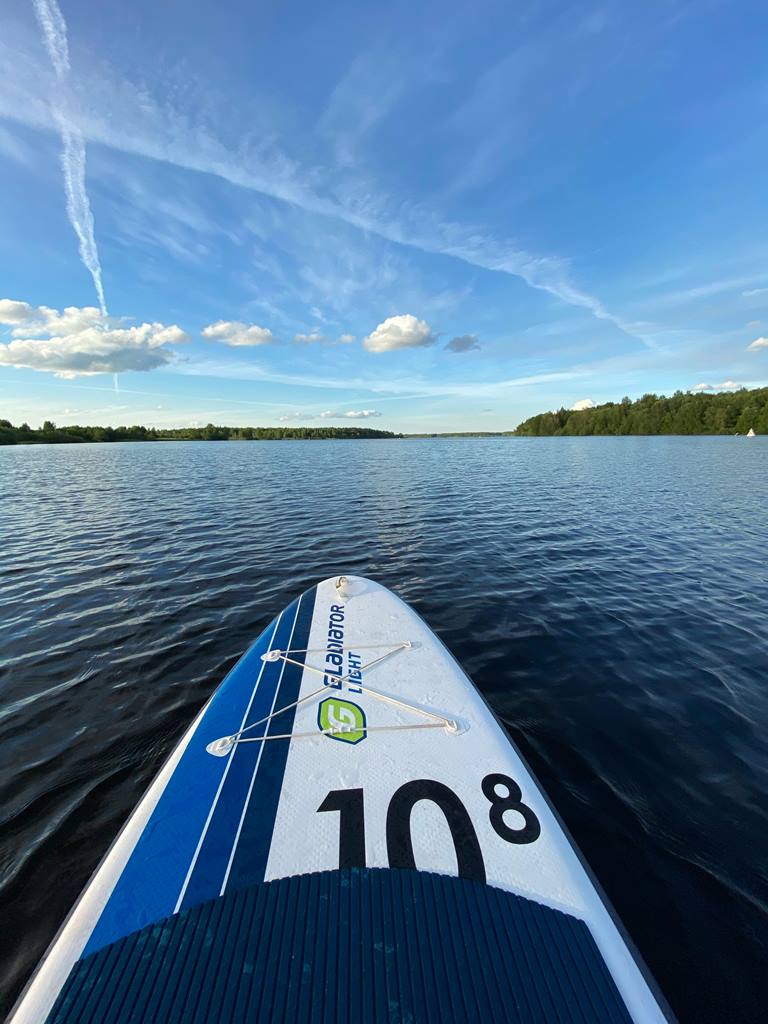
Now that we’ve covered planning, safety, and pre-departure checks, let’s delve into the heart of your kayak camping adventure: choosing the right gear!
The key is to strike a balance between having everything you need and keeping your kayak manageable. Here’s what to consider:
Essential Kayak Gear:
- Kayak: This might seem obvious, but choose a kayak suitable for overnight trips. Sit-in kayaks offer better protection from the elements, while sit-on-top kayaks provide more storage space.
- Paddle: A sturdy, well-fitting paddle is crucial. Consider a two-piece paddle for easier storage in your kayak.
- Personal Flotation Device (PFD): A properly sized and comfortable PFD is essential for safety.
- Bilge Pump or Sponge: A bilge pump or sponge helps remove any water that might accumulate in your kayak.
- Spray Skirt (Sit-in Kayaks): Protects you from getting splashed or swamped by waves.
- Dry Bags: Keep your gear protected from water and moisture.
Camping Gear:
- Tent: Choose a lightweight, compact tent designed for backpacking or kayak camping.
- Sleeping Bag: Select a sleeping bag with a temperature rating appropriate for your expected weather conditions.
- Sleeping Pad: Provides insulation and comfort from the ground.
- Camp Stove and Fuel: A compact, fuel-efficient camp stove is essential for preparing meals.
- Cooking Gear: Pots, utensils, plates, and mugs suitable for backpacking or camping.
- Water Filtration System or Purification Tablets: Treat water from lakes or streams for safe drinking.
- Headlamp and Flashlight: Provide essential lighting for nighttime activities.
- First-Aid Kit: Be prepared for minor injuries or medical emergencies.
- Repair Kit (for Kayak): Pack basic tools and materials to address minor kayak repairs on the go.
Additional Considerations:
- Clothing: Pack quick-drying, breathable clothing appropriate for the weather and water activities. Don’t forget sun protection and a change of clothes.
- Food and Water: Plan your meals carefully, considering weight and perishability. Pack enough water for your entire trip.
- Navigation: A map, compass, or GPS device can help you stay oriented on the water.
- Safety Essentials: Sun protection, insect repellent, whistle, and a signalling device (whistle, flares).
- Trash Bags: Pack out all your trash to preserve the natural environment.
Overnight Kayak Camping and Gear Checklist
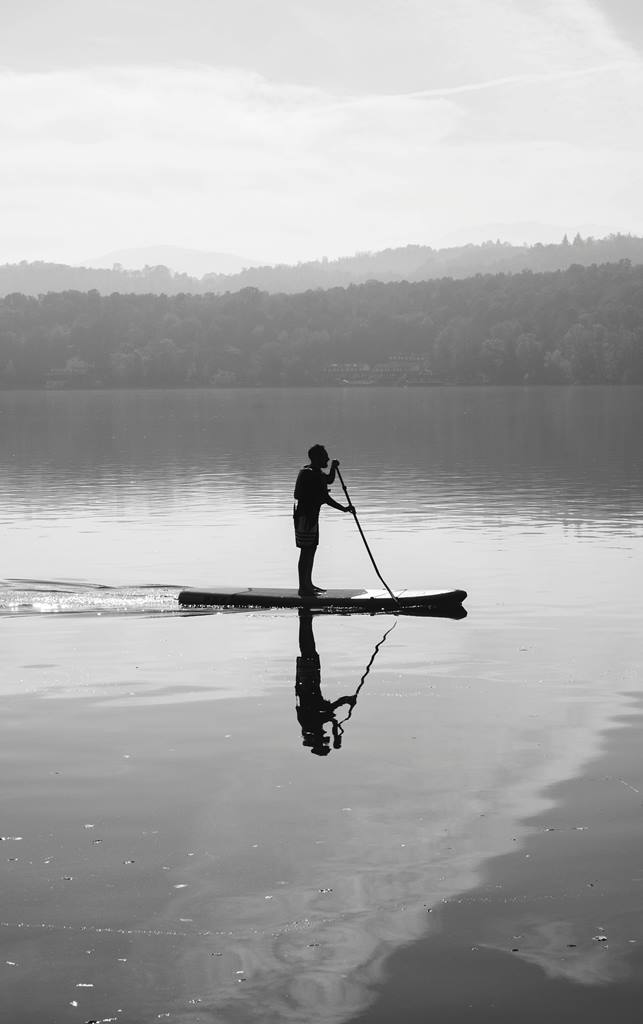
Shelter, Safety, and Survival
Now that we’ve explored choosing the right kayak, let’s delve into the specific gear you’ll need for a comfortable and safe kayak camping trip. Here’s a breakdown of the essentials:
Shelter:
- Kayak with Storage: While sit-in kayaks can work, consider a sit-on-top kayak for its ample storage space with bungee cords at the front and back to secure your gear.
- Tent: A lightweight, waterproof tent becomes your haven after a long day on the water. Choose one suitable for backpacking or kayak camping for optimal portability. For seasoned campers, opting to sleep under the stars is an option, but be sure to check weather conditions and mosquito activity.
Bedding and Comfort:
- Sleeping Bag: A lightweight sleeping bag with a temperature rating appropriate for your expected weather is essential.
- Sleeping Pad: Provides insulation and comfort from the ground. Choose a compact, packable option.
Clothing and Weather Protection:
- Dry Bags: These waterproof bags keep your clothes and other gear protected from moisture and splashes.
- Quick-drying Clothing: Pack breathable, moisture-wicking clothing that dries quickly, ideal for paddling and various weather conditions.
- Rain Gear: Pack light rain gear to shield yourself from unexpected downpours.
Essential Lighting:
- Headlamp: A headlamp provides hands-free illumination for nighttime activities like setting up camp or navigating after dark.
- Flashlight: A secondary light source is a wise addition for emergencies or exploring after sunset.
Safety and Survival:
- First-Aid Kit: Be prepared for minor injuries with a well-stocked first-aid kit.
- Life Jacket: This crucial safety gear is mandatory. Choose a comfortable, properly sized PFD (Personal Flotation Device) that you’ll wear consistently.
- Navigation: Consider packing a map, compass, or GPS device to maintain a sense of direction on the water.
- Safety Essentials: Sun protection, insect repellent, a whistle for emergencies, and a signaling device like flares are vital for outdoor safety.
- Repair Kit (for Kayak): Pack basic tools and materials to address minor kayak repairs on the go.
- Trash Bags: Pack out all your trash to leave no trace and preserve the natural environment.
Additional Considerations:
- Camp Stove and Fuel: A compact, fuel-efficient camp stove allows you to cook meals during your trip.
- Cooking Gear: Pack lightweight, portable pots, utensils, plates, and mugs for camp cooking.
- Water Filtration System or Purification Tablets: Treat water from lakes or streams for safe drinking.
- Food and Water: Plan your meals carefully, considering weight, perishability, and necessary hydration for your entire trip.
Remember: Prioritize lightweight, compact gear whenever possible. The next section will explore space-saving packing strategies to maximize your kayak’s capacity and ensure a smooth and balanced journey!
Note:
- While a satellite phone can be helpful in emergencies, it’s not essential for all kayak camping trips. Consider the remoteness of your destination and your risk tolerance when making this decision.
- An axe is generally not necessary for casual kayak camping trips. A small survival knife can be helpful for minor tasks but prioritize other essential gear first.
Food and Cooking Gear
Now that we’ve covered shelter and safety essentials, let’s delve into the delicious world of kayak camping cuisine! Here’s what you’ll need to prepare and enjoy tasty meals on the water:
Cooking Gear:
- Camp Stove: Compact and lightweight camp stoves are perfect for kayak camping. Opt for a fuel-efficient model to minimize weight and maximize cooking time.
- Portable Grill (Optional): For larger groups, a small portable grill can provide more cooking space. However, prioritize a camp stove for its portability if space is limited.
- Cooking Utensil Kit: Ditch Bear Grylls’ methods and pack a lightweight utensil kit. These compact kits often include everything you need for camp cooking, like sporks, spatulas, and even cutting boards.
Food Storage and Preservation:
- Cooler: Since fridges are nonexistent in the wilderness (unless you’re in Antarctica!), a cooler is essential for keeping your drinks and perishable food chilled. Choose a hard-shell or soft-shell cooler that fits comfortably on your kayak’s bungee deck.
Food Choices:
- Planning is Key: Given limited cooking facilities, plan your meals carefully. Consider calorie-dense options to fuel your paddling endeavours.
- Hearty Options: Pack non-perishable or easily prepared foods like canned or pre-cooked meats, vegetables, nuts, and ready-to-eat meals.
- Dehydrated Meals (Optional): For the truly adventurous, dehydrating your own meals at home allows for customized, lightweight options.
Beverages:
- Coffee/Tea: Start your day with a hot cup of coffee or tea, a delightful way to embrace the morning wilderness.
- Water Bottle: Hydration is crucial, especially during physical activity. Reusable water bottles are eco-friendly and many can keep your drinks hot or cold for extended periods.
Miscellaneous Must-Haves for a Smooth Trip:
- Dry Bags: These are essential for keeping your gear organized and protected from water. Even if you capsize, dry bags ensure you have dry clothes to change into.
- Power Bank: In areas with a phone signal, a power bank keeps your phone charged for navigation, flashlight use, or sending updates.
- Trash Bags: Pack out everything you pack in. Use trash bags to collect garbage, separate dirty laundry, or store wet gear.
- Sunscreen: Apply sunscreen liberally, regardless of the weather, to prevent sunburn and discomfort while paddling.
- Insect Repellent: Bug bites are a real buzzkill. Pack insect repellent to keep unwanted pests at bay.
Tips for Kayak Camping

- For your first trip, consider going with experienced kayak campers. Learn from their experience and avoid common mistakes.
- Pack plenty of water in collapsible containers to save space on the return trip. Stay hydrated throughout your paddle!
- Remove tent poles from their bag and store them near your seat for a more compact tent fit in your kayak.
- Bring extra essentials like matches, batteries, and food to ensure you’re prepared for minor mishaps.
- Pack wet wipes and toilet paper for sanitation since restrooms might be scarce
- Have a Plan B campsite in mind in case your primary choice is unavailable or unsuitable.
- Learn CPR, first aid, fire-starting, and navigation skills. These could be lifesaving in an emergency.
- If encountering bears is a possibility, use a bear-proof food storage system to keep your food safe.
- When stopping for the night, pull your kayak onto land and secure it near your tent to prevent theft or damage.
- Pack items you’ll need during paddling on top of your kayak for quick retrieval without unpacking everything mid-journey.
FAQ’S
Can you go camping with a kayak?
Absolutely! Kayak camping is a fantastic way to explore remote areas and enjoy the beauty of nature from a unique perspective. Kayaks allow you to access secluded campsites unreachable by car or foot.
Is kayak camping difficult?
Kayak camping is not inherently difficult, but it does require some planning and preparation. The basic steps involve:
1- Choosing a suitable kayak with adequate storage space. Packing essential camping gear that prioritizes lightweight and compact options.
2- Planning your route and finding campsites suitable for kayak access. Understanding kayak safety practices and potential challenges on the water.
What type of kayak is best for kayak camping?
For camping with a kayak, choose a sit-on-top kayak. They have more storage space than sit-in kayaks. If you’re buying a kayak just for camping, pick one that’s long and has a wide deck. This helps with packing and fitting your gear.
What are the top tips for kayak camping?
Here are some key tips for kayak camping:
1- Go with experienced kayak campers.
2- Stay hydrated by bringing plenty of water.
3- Store long items like tent poles near your seat.
4- Bring extra essentials such as batteries, matches, and food.
5- Carry wet wipes and toilet paper.
6- Have backup campsites (plan A and plan B).
7- Learn safety and survival techniques.
8- Use bear-proof food containers in bear-prone areas.
9- Secure your kayak overnight.
10- Keep important items easily accessible on top.
How much gear should I bring for kayak camping?
Your kayak’s maximum load capacity determines how much gear you can take. Each kayak has a weight limit, and you must stay below it for optimal performance. Overloading your kayak makes it harder to paddle and steer. To ensure you’re within the limit, compare your weight, any passengers, and your gear’s total weight with your kayak’s capacity. If you exceed it, prioritize essentials and trim down your gear list.

